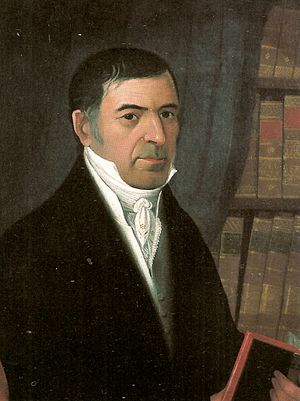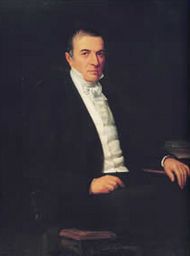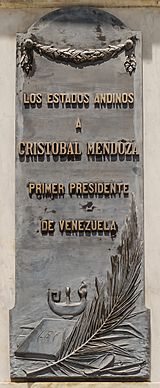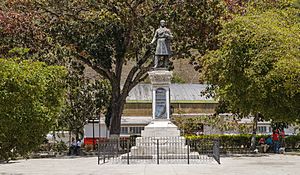Cristóbal Mendoza facts for kids
Quick facts for kids
Cristóbal Mendoza
|
|
|---|---|

Portrait by Juan Lovera
|
|
| 1st President of the First Republic of Venezuela | |
| In office 5 March 1811 – 21 March 1812 |
|
| Preceded by | Office established; Francisco Tomás Morales as Captain General of Venezuela |
| Succeeded by | Francisco Espejo |
| Personal details | |
| Born |
José Cristóbal Hurtado de Mendoza y Montilla
23 June 1772 Trujillo, Viceroyalty of New Granada, Spanish Empire |
| Died | 8 February 1829 (aged 56) Caracas, Gran Colombia (now Venezuela) |
| Spouses | Juana Mendoza Briceño Mendez Maria Regina Montilla Pumar Gertudis Buroz Tovar |
| Signature |  |
José Cristóbal Hurtado de Mendoza y Montilla (born June 23, 1772 – died February 8, 1829) was a very important Venezuelan leader. Most people know him as Cristóbal Mendoza. He was a lawyer, a politician, and a writer. He is famous for being the first official President of Venezuela. He served from 1811 to 1812.
Cristóbal Mendoza studied a lot. He earned a master's degree in philosophy in Caracas. Later, he got a special law degree in the Dominican Republic. This degree was for both church law and regular civil law. Early in his career, he worked as a lawyer in different cities. These included Trujillo, Mérida, and Caracas.
In 1796, he moved to Barinas to continue his law work. By 1807, he was elected Mayor of Barinas. In 1810, Mendoza joined a group of people in Caracas. They wanted to break free from Spanish rule. In 1811, he was chosen to represent Barinas in Venezuela's new Congress. Just a few days later, he became the first president of the First Republic of Venezuela. He shared this role with two other leaders.
During his time as president, Mendoza helped start the fight for independence. This was against the parts of Venezuela that still supported Spain. He also wrote the Venezuelan Declaration of Independence. This important document declared Venezuela's freedom. He also helped create the first Constitution of Venezuela. His term ended in March 1812.
In 1813, Mendoza had to leave Venezuela because of a Spanish attack. He moved to Grenada. Soon after, he joined Simon Bolivar's efforts. Bolivar was working to free South America from Spanish control. Bolivar made Mendoza the governor of Mérida in May 1813. A few months later, he became governor of Caracas.
Mendoza had to leave Venezuela again in 1814. This was when José Tomás Boves took over Caracas. Mendoza moved to Trinidad. From 1819 to 1820, he wrote many political articles there. He wrote for a newspaper called Correo del Orinoco. In 1826, Francisco de Paula Santander appointed Mendoza as Mayor of the Department of Venezuela. This was part of the large country called Gran Colombia. After a short time away, Simon Bolivar re-appointed him to this role in 1827. Mendoza kept this job until he resigned in mid-1828. To honor Mendoza, Venezuela created National Lawyer Day in 1972. It is celebrated on his birthday, June 23.
Early Life and Education
José Cristóbal Hurtado de Mendoza y Montilla was born in Trujillo, Venezuela. His birthday was June 23, 1772. His parents were Luis Bernardo Hurtado de Mendoza y Valera and Gertrudis Eulalia Montilla y Briceño. His father taught him at a Franciscan Monastery. Friar Antonio de Pereira was his teacher there.
When he was 16, he went to Caracas for more schooling. He studied at the university. In 1791, he earned a bachelor's degree in philosophy. He continued studying for his master's degree until 1793. After that, he went to a university in Santo Domingo. This city is in the Dominican Republic. In 1794, he earned a special doctorate degree there. It was for both church law and civil law. This made him a "Doctor of Canon and Civil Law."
After getting his doctorate, Mendoza returned to Venezuela. He was in his early twenties. He started working as a lawyer in his hometown. First, he worked in a law office in Trujillo. In 1795, he practiced law in Mérida. For a short time in 1795, he also taught philosophy. He taught at a college in Mérida. Mendoza later moved to Caracas to finish his law training. He officially became a lawyer on July 10, 1796. He then moved to Barinas in late 1796. He continued his law practice there.
Political Career
1807–1809: Mayor of Barinas and Congress
After becoming a lawyer, Mendoza moved to Barinas. There, he became known for helping local groups. He also helped them invest their money in farms. In January 1807, the Council of Barinas elected him Mayor. There were some questions about how he was elected. But in 1808, a special court said Mendoza could keep his position.
On April 19, 1810, Mendoza joined a movement in Caracas. This group of important citizens wanted to break away from Spain. In May 1810, he became the secretary of a new local government in Barinas. He also led a group of wealthy citizens in Caracas. Their motto was: "Peace and calm are what we want. Die or be free is our goal."
Mendoza and his brother were chosen to represent Barinas. This was for the new Congress of Venezuela. The Congress started on March 2, 1811. However, Mendoza did not get to serve in the Congress. On March 5, 1811, he was chosen as president of the First Republic of Venezuela. At that time, he was getting ready to travel to Caracas. He was also working with the new Board of Governors.
1811–1812: President of Venezuela
In March 1811, during the Spanish American wars of independence, Venezuela's first congress made a new plan for leadership. They created a "triumvirate." This meant three men would share the top power. They would take turns being president each week. Mendoza was 39 years old. He became one of these three leaders of the First Republic of Venezuela. On March 5, 1811, the other two leaders chose him to be the first to serve.
Mendoza arrived in Caracas on April 25, 1811. He began his first week as president. As part of the triumvirate, Mendoza helped start the fight for independence. This was against parts of Venezuela that still supported the Spanish king. He also wrote the Venezuelan Declaration of Independence. This important document was issued on July 5, 1811. While in office, he helped create the first Constitution of Venezuela. This was finished in December 1811. In March 1812, a new group of three presidents was chosen. Mendoza and the others stepped down.
1813–1820: Governor of Mérida and Caracas
The First Republic of Venezuela ended in 1813. This happened after a Spanish attack led by Captain Domingo de Monteverde. After this, Mendoza moved to the island of Grenada. He then joined Brigadier Simon Bolivar's fight. Bolivar was getting ready to free Venezuela from Spain.
Bolivar made Mendoza the governor of Mérida. Mérida had joined Bolivar's cause in May. Mendoza entered the city on May 23, 1813. He also became governor of the wider Mérida province. During a very intense period of fighting started by Bolivar, Mendoza did many jobs. He managed government, taxes, and supplies for the army. He also helped with hospitals and watched for spies.
Bolívar then made Mendoza governor of the province of Caracas. Mendoza arrived in Caracas on August 6, 1813. In Caracas, Mendoza suggested a special meeting. On October 14, 1813, at this meeting, Bolivar was given the title "Liberator." On January 2, 1814, a public assembly confirmed Bolivar as the top commander. He led the army fighting for freedom from Spain.
In July 1814, the forces of José Tomás Boves took over Caracas. Mendoza and his family had to escape. They went to different islands in the West Indies. Finally, they settled in Trinidad. From 1819 to 1820, Mendoza supported the Venezuelan cause. He wrote newspaper articles for the Correo del Orinoco. He used the pen name "a patriot." He wrote about government and world issues. He especially argued against having kings in the Americas.
1821–1826: Justice Minister and Private Practice
After the Battle of Carabobo in June 1821, Venezuela became independent. Mendoza returned to Caracas with his family in late 1821. He was named Justice Minister of Gran Colombia. This role was also like being president of the High Court of Justice in Venezuela. While in this job, Mendoza kept studying law and history. He also helped edit a newspaper called El Observador Caraqueño.
Mendoza left his Justice Minister role in 1825. He went back to working as a private lawyer. His law firm had some good times and some not-so-good times. He also worked on public projects. For example, he wanted to build a new road between La Guaira and Caracas. This project did not happen. Even though he wasn't running, he got the most votes for vice president in Venezuela in 1825. In 1826, he and Francisco Javier Yánez published an important study about Bolivar. It was called Collection of documents relating to the public life of the Liberator of Colombia and Peru, Simon Bolivar. Mendoza published 22 books in total.
1826–1828: Mayor of the Department of Venezuela
In April 1826, Francisco de Paula Santander appointed Mendoza as Mayor of the Department of Venezuela. This happened during a time of political unrest called El Cosiata. This was a movement led by José Antonio Páez. They wanted Venezuela to separate from Bolivar's Gran Colombia.
In his new job, Mendoza tried to calm things down. He wanted to stop fighting between different groups in Venezuela. He tried to prevent more conflict. But he could not convince Caracas not to join the plan to break up Gran Colombia. General Jose Antonio Paez then sent Mendoza away from Venezuela. Mendoza went to the island of Saint Thomas on November 27, 1826. His family stayed in Caracas.
Bolivar returned to Caracas at the end of 1826. Peace returned to the city by January 1827. After Bolivar got power back, he invited Mendoza to return to Venezuela. Bolivar re-appointed Mendoza as Mayor of the Department of Venezuela. Mendoza kept this job until he resigned in the middle of 1828. Some people think he resigned because of new tax rules.
Death
Mendoza's health was not good. In mid-1828, he resigned from his job as mayor. He retired to an area outside Caracas. On his deathbed, he wrote a letter to Bolivar. He said his most important possessions were "the memory of my small services for the republic and the memories of our lifelong friendship." Cristóbal Mendoza died in Caracas on February 8, 1829.
Mendoza's funeral was on February 9, 1829. It took place in the Church of San Pablo. He was first buried in a place called "Brothers of San Pedro." Years later, he was buried in the Church of Altagracia. In October 2014, a politician suggested moving Mendoza's remains. They wanted to move them to the National Pantheon of Venezuela. This is a special place for national heroes.
Views and Legacy
Cristóbal Mendoza believed that Latin American countries should join together. He did not agree with José Antonio Páez's efforts to separate. The way Mendoza helped lead Venezuela in 1811 was with three presidents. This idea was later criticized by Simon Bolivar. But it showed that Mendoza believed in a government with a constitution, like in the United States.
Mendoza was a loyal and trusted helper to Simon Bolivar. He collected many documents about Bolivar's public life. He published 20 small books of these documents between 1824 and 1828. Bolivar supposedly said about Mendoza: "You are the man I admire most in this world. You show what it means to be good and helpful."
In 1972, Venezuela created National Lawyer Day. It is celebrated on Mendoza's birthday, June 23. President Rafael Caldera Rodriguez made this holiday. It was requested by the Federation of Associations of Venezuela.
Personal Life
Mendoza moved to Barinas from Caracas in late 1796. There, he married Juana Mendez Mendoza Briceño. She died shortly after. In the early 1800s, he married again to Maria Regina Montilla of Pumar. She was related to Jose Ignacio of Pumar. She also passed away by 1810. On August 14, 1811, Mendoza married for a third time to Gertrudis Buroz Tovar. Cristóbal Mendoza had 17 children.
Two of his grandsons moved to Cuba. They fought for Cuba's independence from Spain. This was during the Ten Years War (1868–1878). Cristóbal Mendoza Durán was a journalist. He joined the army fighting for freedom. Carlos Manuel de Cespedes made him the Foreign Secretary. This was for the first government of the Republic of Cuba. His brother Tomás was also a journalist. He worked as an assistant to General Manuel de Quesada. Both Cristóbal and Tomás Mendoza died fighting in Cuba.
Other people related to Cristobal Mendoza include Eugenio Mendoza, Eduardo Mendoza Goiticoa, Lorenzo Mendoza, and Leopoldo López.
See also
 In Spanish: Cristóbal Mendoza para niños
In Spanish: Cristóbal Mendoza para niños
- List of presidents of Venezuela
- List of Venezuelans
- Elections in Venezuela
- Politics of Venezuela




